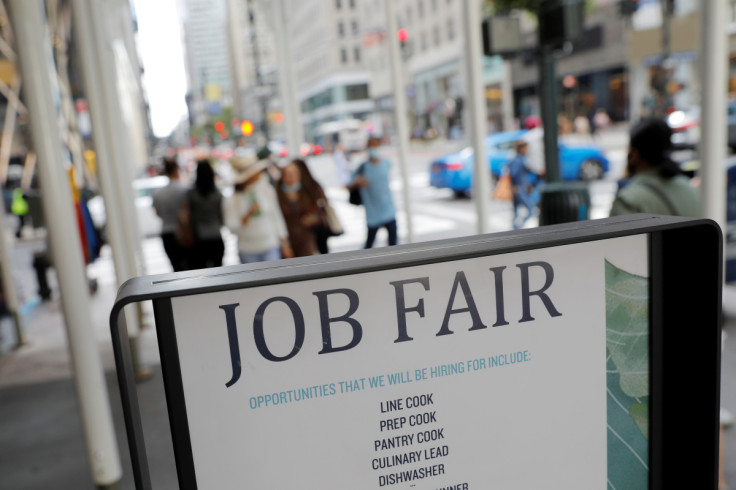U.S. labor market strong at end of 2022; trade gap narrows sharply
The number of Americans filing new claims for jobless benefits dropped to a three-month low last week while layoffs fell 43% in December, pointing to a still-tight labor market that could force the Federal Reserve to keep hiking interest rates.

The number of Americans filing new claims for jobless benefits dropped to a three-month low last week while layoffs fell 43% in December, pointing to a still-tight labor market that could force the Federal Reserve to keep hiking interest rates.
Labor market resilience was underscored by other data on Thursday showing private employers hired far more workers than expected last month. The reports suggested the economy ended 2022 on solid footing, despite a raft of layoffs in the technology industry as well as in interest rate-sensitive sectors like finance and housing.
The sustained jobs market strength raises the risk that the Fed, engaged in its fastest interest rate-hiking cycle since the 1980s as it tries to dampen demand to tame inflation, could boost its target interest rate above the 5.1% peak the U.S. central bank projected last month and keep it there for a while.
"Fed officials are expecting a slowing in the job market given the big increase in interest rates last year," said Stuart Hoffman, senior economic advisor at PNC Financial in Pittsburgh, Pennsylvania. "Right now the labor market is too tight for the Fed, and job growth is too strong."
Initial claims for state unemployment benefits decreased 19,000 to a seasonally adjusted 204,000 for the week ended Dec. 31, the lowest level since the end of September, the Labor Department said. Economists polled by Reuters had forecast 225,000 claims for the latest week. Through the volatility of the year-end holidays, claims have remained at very low levels.
Unadjusted claims rose only 5,703 to 275,552 last week. There were notable increases in claims in New Jersey, New York, Pennsylvania and Michigan, which offset decreases in Missouri, Texas and Kentucky.
Economists speculated that severance packages and still-strong demand for labor, which made it easier for laid-off workers to get another job, were keeping claims low. They also said companies are likely to slow hiring before embarking on layoffs after struggling to find labor during the pandemic.
The Labor Department reported on Wednesday that there were 10.458 million job openings at the end of November, which translated to 1.74 jobs for every unemployed person.
U.S. stocks were trading lower. The dollar rose against a basket of currencies. U.S. Treasury prices fell.
VERY TIGHT LABOR MARKET
The Fed last year hiked its policy rate by 425 basis points from near zero to a 4.25%-4.50% range, the highest since late 2007. Last month, it projected at least an additional 75 basis points of increases in borrowing costs by the end of 2023.
Minutes of the Fed's Dec. 13-14 policy meeting, which were published on Wednesday, showed officials noted that the labor market remained "very tight," with a "few remarking that some business contacts reported that they would be keen to retain workers even in the face of slowing demand for output because of their recent experiences of labor shortages and hiring challenges."
The claims report also showed the number of people receiving benefits after an initial week of aid, a proxy for hiring, dropped 24,000 to 1.694 million in the week ending Dec. 24. The so-called continuing claims had jumped to an 11-month high of 1.718 million in the prior week.
Economists were divided on whether this indicated some loosening of labor market conditions or year-end volatility.
"Through some of the ups and downs in the series over recent months, filings for both initial claims and continuing claims generally have been coming in at low levels by the standards of recent decades, which is indicative of labor market strength," said Daniel Silver, an economist at JPMorgan in New York.
A separate report from global outplacement firm Challenger, Gray & Christmas on Thursday showed U.S.-based employers announced 43,651 job cuts in December, down 43% from November. The total was, however, 129% higher compared to December 2021 and was the second-largest monthly number announced in 2022.
The bulk of the job cuts were in the technology sector. For the whole of 2022, job cuts increased 13% to 363,824. It was still the second-lowest recorded annual total since Challenger began tracking the series in 1993.
A third report showed private payrolls increased by 235,000 jobs last month after rising by 182,000 in November. Economists had expected the ADP National Employment report would show an increase of 150,000 private jobs.
The reports were published ahead of the release on Friday of the Labor Department's more comprehensive and closely watched employment report for December. According to a Reuters survey of economists, nonfarm payrolls are forecast to have advanced by 200,000 jobs. The economy created 263,000 jobs in November.
There was more goods news on the economy, from the gross domestic product accounting perspective. A fourth report from the Commerce Department showed the trade deficit narrowed 21.0% to $61.5 billion in November, the lowest level since September 2020. The trade gap contraction, the biggest since February 2009, reflected a slump in goods imports to a 13-month low.
While a smaller import bill is a boost to GDP, it is also a sign that domestic demand is cooling amid stiff borrowing costs. Nevertheless, it will offset the weakness in exports. A smaller trade deficit was the largest contributor to the economy's 3.2% annualized growth pace in the third quarter. Growth estimates for the fourth quarter are as high as a 3.8% rate.
"Trade will support fourth-quarter GDP," said Ryan Sweet, chief economist at Oxford Economics. "Solid economic growth increases the risk that the recession arrives later than our current second-quarter 2023 baseline expectation."
Copyright Thomson Reuters. All rights reserved.






